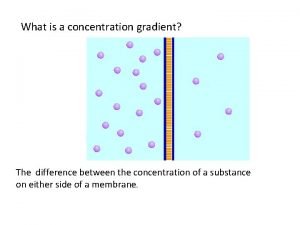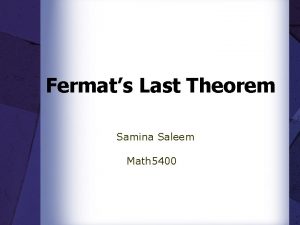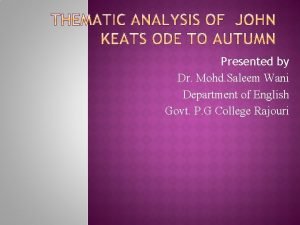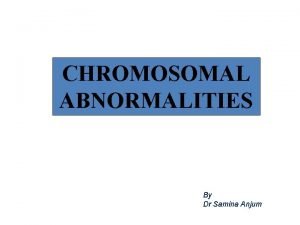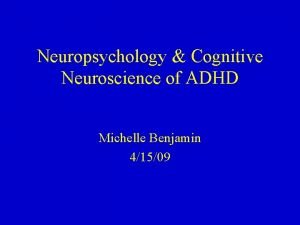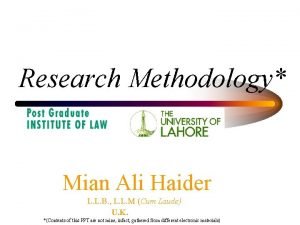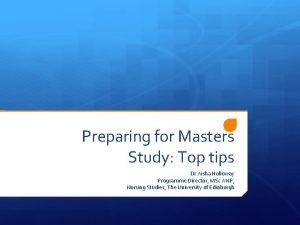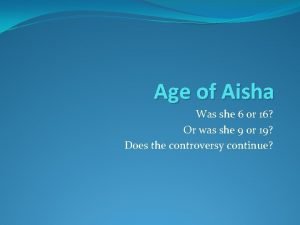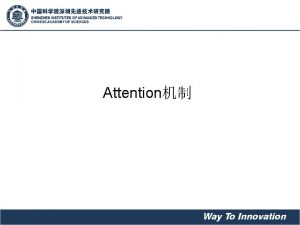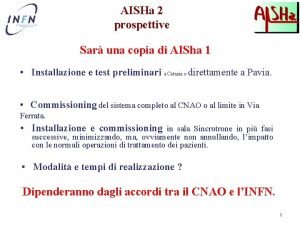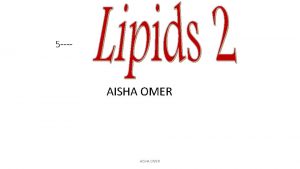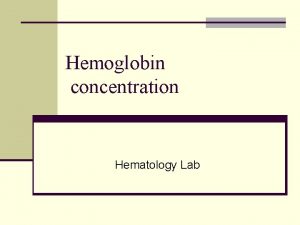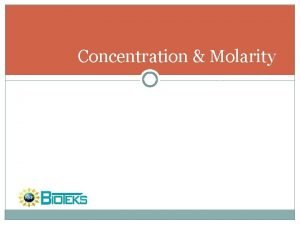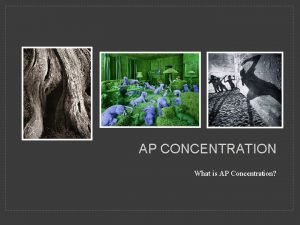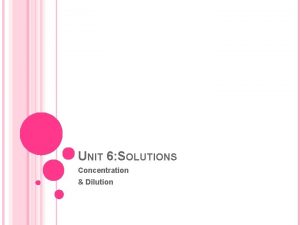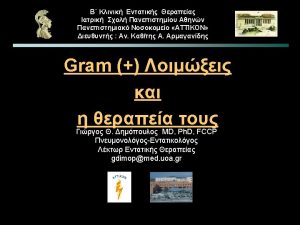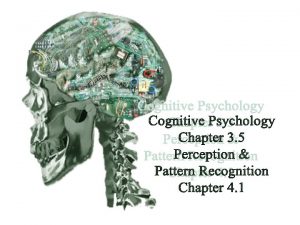ATTENTION AND CONCENTRATION Aisha Saleem What is Attention



















- Slides: 19

ATTENTION AND CONCENTRATION Aisha Saleem

What is Attention? Attention is something which we often take for granted. It is our ability to concentrate or focus on a chosen stimulus and ignore all of the other options in our environment. Attention can be split up into four distinct aspects: Focused or selective attention Sustaine d attention or vigilance Divided attention Alternatin g attention

Attention It refers to how we actively process specific information present in our environment. Types of Attention Focused or selective attention It is our ability to focus on one or two important stimuli while ignoring competing distractions. This is the kind of attention used when we are actively attending to something. It is our ability to attend to one thing to the exclusion of everything else. For example when you are studying or driving.

Sustained attention or vigilance – This is the ability to concentrate on one task for a certain period of time without switching off. Divided attention- Involves the ability to respond to more than one task at a time or to multiple elements or operations within a task. Alternating attention – This allows for shifts in focus and tasks. This often happens at work, for example if we are typing a report and then the telephone rings and suddenly we have to concentrate on requests on the other end of the phone. The strength our brains have is that they are then able to go back to the report once the phone call is dealt with.

Determinants of Attention 1. External factors or condition 2. Internal factors

I. External Factors or Condition: These conditions are generally those characteristics of outside situation or stimuli which make the strongest aid for capturing our attention.

1. Nature of the stimulus: All types of stimuli are not able to bring the same degree of attention. A picture attracts attention more readily than words. Among the pictures, the pictures of human beings invite more attention and those of human beings related to beautiful women or handsome men, who attract more attention. In this way an effective stimulus should always be chosen for capturing maximum attention.

2. Intensity and size of the stimulus: In comparison with the weak stimulus, the immense stimulus attracts more attention of an individual. Our attention become easily directed towards a loud sound, a bright light or a strong smell, and also a large building will be more readily attended to, than a small one.

3. Contrast, change and variety: Change and variety strike attention more easily than sameness and absence of change, e. g. we do notice the ticking sound of a clock put on the wall until it stops ticking, that is any change in the attention to which you have been attracted immediately capture your attention. The factor, contact or change is highly responsible for capturing attention of the organism and contributes more than the intensity, size or nature of the stimulus.

4. Repetition of stimulus: Repetition is the factor of great importance in securing attention. Because one may ignore a stimulus at first instance, but if it is repeated for several times it captures our attention, e. g. a miss-spelled word is more likely to be noticed, if it occurs twice in the same paragraph than, if it occurs only once. While giving lecture the important aspects of the speech are often repeated so that the attention of the audience can be easily directed to the valuable points.

5. Movement of the stimulus: The moving stimulus catches our attention more quickly than a stimulus that does not move. We are more sensitive to objects that move in our field of vision, e. g. advertisers make use of this fact and try to catch the attention of people through moving electric lights.

II. Internal or Subjective Factors: These factors predispose the individual to respond to objective factors, to attend to those activities that fulfill his desires and motives and suit his interest and attitude. It is the mental state of the perceiver.

Some of the subjective factors are: 1. Interest: Interest is said to be the mother of attention. We attend to objects in which we have interest. We would like to watch a movie or a serial in TV because we are interested in the subject around which the movie or serial revolves. In any gettogether if any subject of our interest is discussed that attracts our attention easily and makes us to participate in the discussion. In our day-to-day life we pay attention to the stimulus

2. Motives: Our basic needs and motives to a great extent, determine our attention, thirst, hunger, sex, curiosity, fear are some of the important motives that influence attention, e. g. small children get attracted towards eatables.

3. Mind set: Person’s readiness to respond determines his attention. If we are expecting a stimulus, occurrence of that stimulus along with many other stimuli may not come in the way of attending to that particular stimulus. At a time when students are expecting the examination time table by the end of the semester the time table put on the notice board along with other notices would attract their attention easily.

4. Moods and attitudes: What we attend to is influenced by the moods and attitudes. When we are disturbed or in angry mood, we notice the smallest mistake of others very easily. Likewise our favourable and unfavourable attitudes also determine our attention. After discussing subjective and objective factors, we realize that these factors are interrelated. How much or in what way we attend to a stimulus depends on subjective as well as objective factors.

Duration and Degree of Attention: People may possess the ability to grasp a number of objects or in other words, to attend a number of stimuli in one short “presentation”. This ability of an individual is evaluated in terms of the span of attention, which differs from person to person and even situation to situation.

The term “span of attention” is designed in terms of the quality, size extent to which the perceptual field of an individual can be effectively organized in order to enable him to attain a number of things in a given spell of short duration.

References http: //www. psychologydiscussion. net/notes/ps ychology-notes/attention-and-perception/notes -on-attention-meaning-types-and-determinants -psychology/1965
 Whats a concentration gradient
Whats a concentration gradient Movement of high concentration to low concentration
Movement of high concentration to low concentration Samina saleem
Samina saleem Samir saleem
Samir saleem Sea anemone
Sea anemone Saleem beebeejaun
Saleem beebeejaun Dr saleem wani
Dr saleem wani Ranim saleem
Ranim saleem Samina definition
Samina definition Chromosome 13 abnormality
Chromosome 13 abnormality Alternating attention vs divided attention
Alternating attention vs divided attention Farzana kite runner
Farzana kite runner Mian ali haider
Mian ali haider Aisha holloway
Aisha holloway Aisha omer
Aisha omer Year one princess
Year one princess Aisha amian
Aisha amian Aisha bint abu bakr quotes
Aisha bint abu bakr quotes Aisha lone
Aisha lone Age of aisha
Age of aisha
